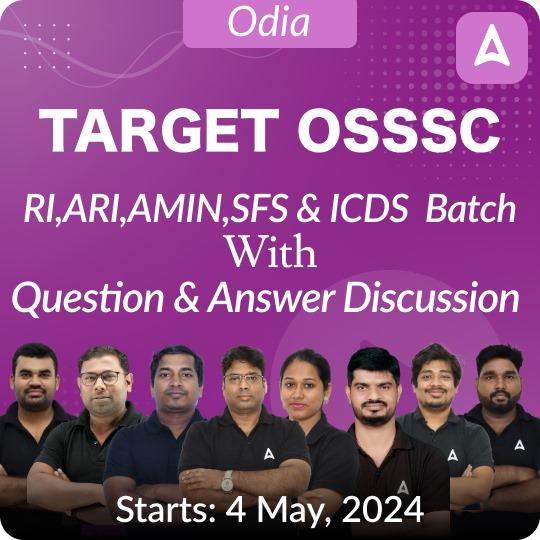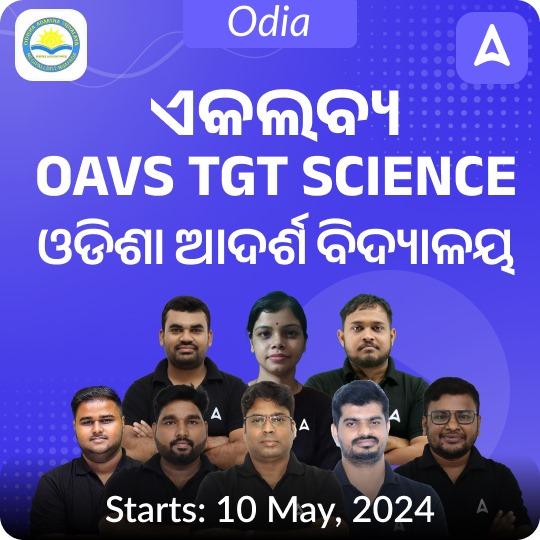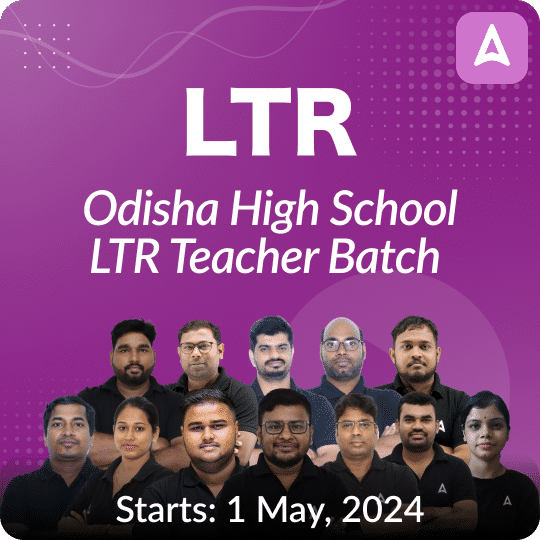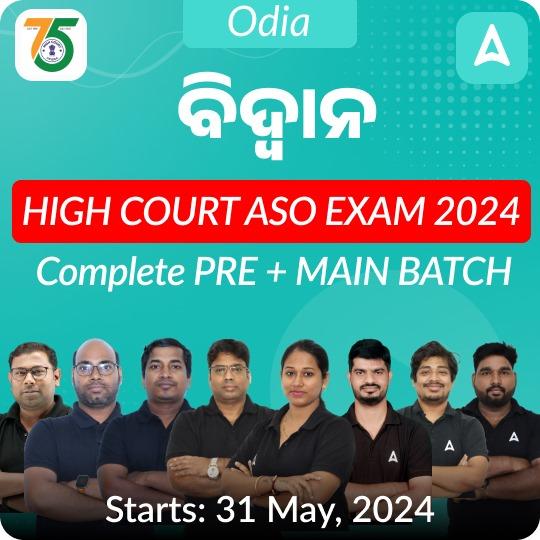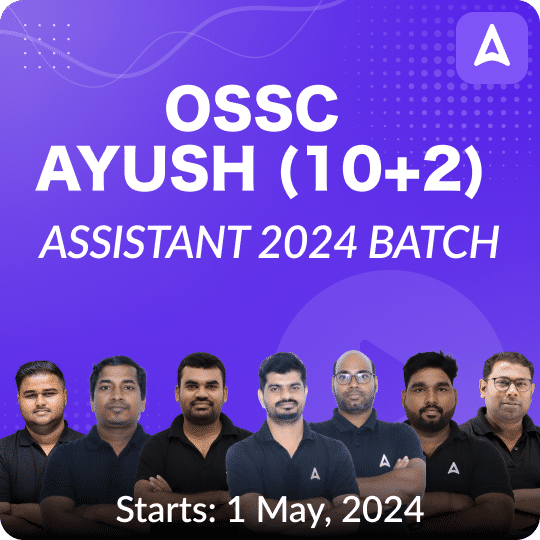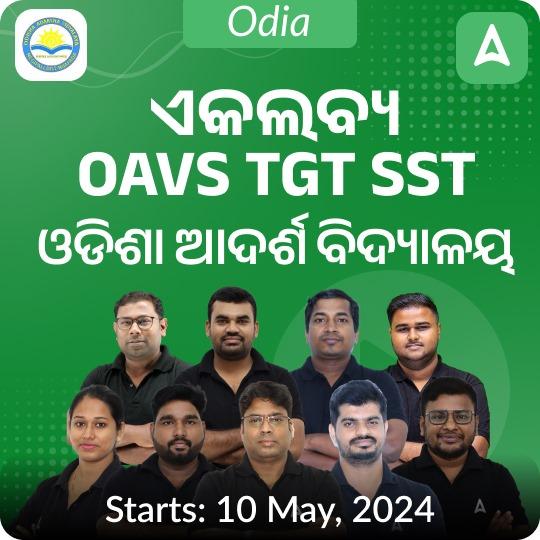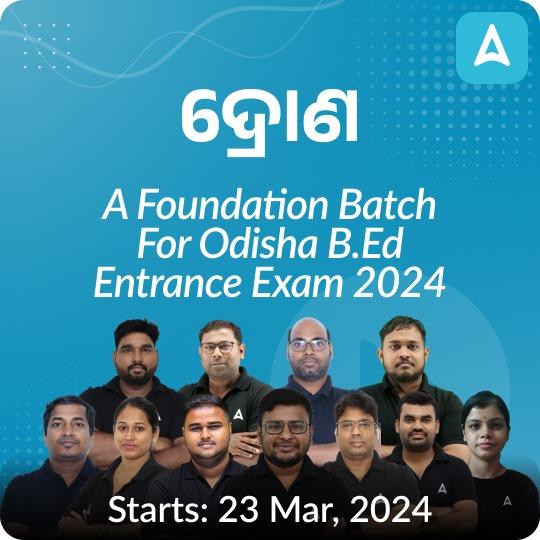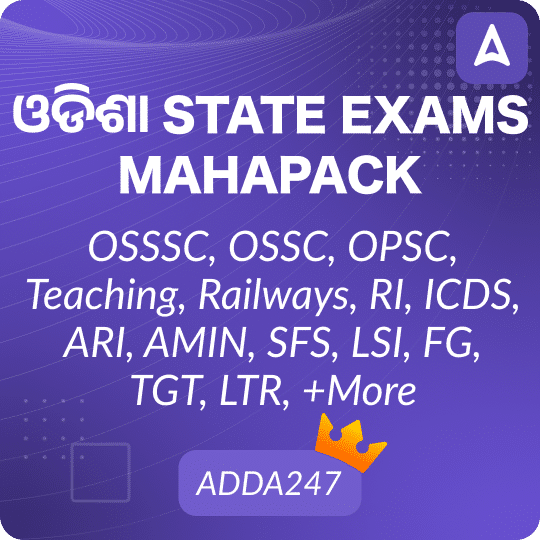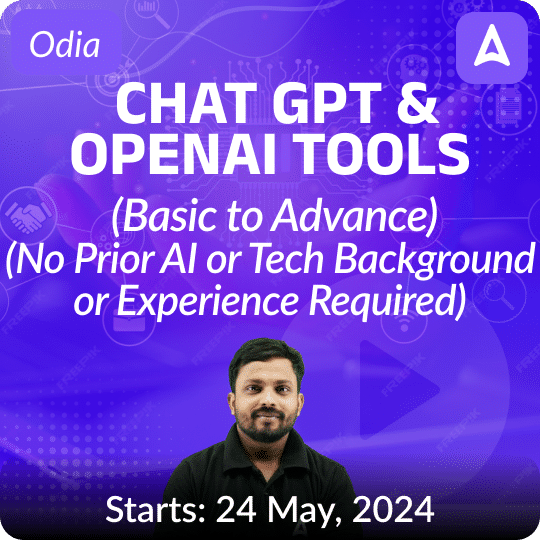Weekly Current affairs play a very important role in the competitive examinations and hence, aspirants have to give undivided attention to it while doing preparation for the government examinations. The CGLRE, OCS examinations comprise a section of “Current Affairs” to evaluate how much the aspirant is aware of the daily happenings taking place around the world. To complement your preparation, we are providing you with a compilation of Weekly Current affairs.
- The Union Ministry of Environment, Forest and Climate Change (MoEFCC) has proposed to notify how many square kilometers around the Gir forest as an Eco-Sensitive Zone (ESZ)?
(a) 1,500 sq km
(b) 2,500 sq km
(c) 3,328 sq km
(d) 4,000 sq km
Ans: (c) 3,328 sq km
Explanation: MoEFCC has proposed to declare 3,328 sq km around Gir forest as an Eco-Sensitive Zone (ESZ) to act as a buffer zone and safeguard the wildlife habitat. - What is the general guideline for the extent of land around national parks and wildlife sanctuaries to be notified as Eco-Sensitive Zones (ESZ)?
(a) 5 km
(b) 8 km
(c) 10 km
(d) 12 km
Ans: (c) 10 km
Explanation: The general guideline for ESZ is to notify land within 10 km of national parks and wildlife sanctuaries, although the extent can vary based on ecological needs. - Which of the following statements is true about Eco-Sensitive Zones (ESZs)?
(a) ESZs are strictly limited to within 10 km of protected areas.
(b) ESZs can extend beyond 10 km if crucial for wildlife movement.
(c) ESZs are primarily aimed at promoting tourism in wildlife areas.
(d) ESZs only exist in forested regions of India.
Ans: (b) ESZs can extend beyond 10 km if crucial for wildlife movement.
Explanation: ESZs can extend beyond 10 km in cases where the region is essential for wildlife movement or ecological connectivity. - The Global Framework on Chemicals Fund was established during which international conference?
(a) ICCM4
(b) ICCM5
(c) COP26
(d) IPCC5
Ans: (b) ICCM5
Explanation: The Global Framework on Chemicals Fund was established during the fifth International Conference on Chemicals Management (ICCM5) in September 2023. - What is the objective of the Global Framework on Chemicals Fund?
(a) Promote research on chemical safety in developed countries
(b) Prevent or minimize harm from chemicals and waste in vulnerable countries
(c) Support the manufacture of chemicals for industrial use
(d) Fund chemical companies in developing nations
Ans: (b) Prevent or minimize harm from chemicals and waste in vulnerable countries
Explanation: The fund is aimed at helping developing, least developed, and transitioning economies manage chemicals safely and sustainably. - How much financial assistance does the Global Framework on Chemicals Fund provide per project?
(a) $100,000 to $300,000
(b) $300,000 to $800,000
(c) $500,000 to $1 million
(d) $1 million to $2 million
Ans: (b) $300,000 to $800,000
Explanation: The fund provides grants between $300,000 and $800,000 for up to three years to support chemical safety projects. - The English Channel connects the Atlantic Ocean with which sea?
(a) Mediterranean Sea
(b) Baltic Sea
(c) North Sea
(d) Red Sea
Ans: (c) North Sea
Explanation: The English Channel connects the Atlantic Ocean to the North Sea through the Strait of Dover. - Which of the following is true about the climate of the English Channel?
(a) Mediterranean climate with mild winters
(b) Desert climate with hot summers
(c) Temperate maritime climate with warm summers and cold winters
(d) Tropical climate with high humidity year-round
Ans: (c) Temperate maritime climate with warm summers and cold winters
Explanation: The English Channel experiences a temperate maritime climate, characterized by warm summers and cold winters. - Which of the following statements about the English Channel is false?
(a) It is one of the world’s busiest shipping routes.
(b) It separates southern England from northern France.
(c) It was historically known as the “Narrow Sea.”
(d) It connects directly to the Mediterranean Sea.
Ans: (d) It connects directly to the Mediterranean Sea.
Explanation: The English Channel connects to the North Sea, not the Mediterranean Sea. - Kawal Tiger Reserve is located in which state of India?
(a) Madhya Pradesh
(b) Telangana
(c) Karnataka
(d) Odisha
Ans: (b) Telangana
Explanation: Kawal Tiger Reserve is situated in the north-eastern part of Telangana state. - What type of vegetation is found in Kawal Tiger Reserve?
(a) Alpine Forests
(b) Mangrove Forests
(c) Southern Tropical Dry Deciduous Forest
(d) Evergreen Rainforests
Ans: (c) Southern Tropical Dry Deciduous Forest
Explanation: The Kawal Tiger Reserve is home to Southern Tropical Dry Deciduous Forests, along with teak and bamboo. - The Kawal Tiger Reserve is a part of which Tiger Landscape?
(a) Western Ghats
(b) Eastern Ghats
(c) Central Indian Tiger Landscape
(d) Himalayan Tiger Landscape
Ans: (c) Central Indian Tiger Landscape
Explanation: The Kawal Tiger Reserve is located at the southernmost tip of the Central Indian Tiger Landscape. - The Lipulekh Pass is located in which state of India?
(a) Sikkim
(b) Himachal Pradesh
(c) Uttarakhand
(d) Jammu & Kashmir
Ans: (c) Uttarakhand
Explanation: Lipulekh Pass is a high-altitude mountain pass situated in the Kumaon region of Uttarakhand. - The Lipulekh Pass is significant for which religious pilgrimage?
(a) Amarnath Yatra
(b) Kailash Mansarovar Yatra
(c) Char Dham Yatra
(d) Vaishno Devi Yatra
Ans: (b) Kailash Mansarovar Yatra
Explanation: Lipulekh Pass is an important part of the Kailash Mansarovar Yatra route. - When was the first Indian border post at Lipulekh Pass opened for trade with China?
(a) 1982
(b) 1992
(c) 2002
(d) 2012
Ans: (b) 1992
Explanation: The first Indian border post at Lipulekh Pass was opened for trade with China in 1992. - Which of the following rivers is associated with the Kawal Tiger Reserve?
(a) Yamuna
(b) Godavari
(c) Brahmaputra
(d) Ganges
Ans: (b) Godavari
Explanation: Kawal Tiger Reserve serves as the catchment area for the Godavari and Kadam rivers. - What event took place during the World Wildlife Week 2024 in Kawal Tiger Reserve?
(a) A marathon
(b) A cyclothon
(c) A wildlife photography contest
(d) A bird-watching tour
Ans: (b) A cyclothon
Explanation: The forest department organized its first-ever cyclothon in the buffer zone of the Kawal Tiger Reserve as part of World Wildlife Week 2024 celebrations. - The Global Framework on Chemicals Fund provides financial support for how many years per project?
(a) One year
(b) Two years
(c) Three years
(d) Five years
Ans: (c) Three years
Explanation: The fund provides financial support for projects lasting up to three years. - Which country is separated from England by the English Channel?
(a) Germany
(b) France
(c) Belgium
(d) Netherlands
Ans: (b) France
Explanation: The English Channel separates southern England from northern France. - Which of the following fauna is not typically found in the Kawal Tiger Reserve?
(a) Cheetal
(b) Sambar
(c) Snow Leopard
(d) Sloth Bear
Ans: (c) Snow Leopard
Explanation: Snow Leopards are found in high-altitude mountainous regions, whereas Kawal Tiger Reserve is home to species like Cheetal, Sambar, and Sloth Bear. - Who is the newly appointed chairperson of the Odisha Public Service Commission (OPSC)?
(a) B.K. Sharma
(b) Arun Sarangi
(c) Dharmendra Pradhan
(d) Sunil Bansal
Ans. (b) Arun Sarangi
Explanation: Arun Sarangi, a former Director General of Police (DGP) of Odisha, has been appointed as the new chairperson of OPSC. - What is the percentage increase in Odisha’s leopard population according to the All Odisha Leopard Estimation 2024?
(a) 18%
(b) 22%
(c) 25%
(d) 15%
Ans. (b) 22%
Explanation: Odisha’s leopard population increased by 22%, rising from 568 in 2022 to 696 in 2024. - What was the estimated leopard population in Odisha in 2024 according to the new report?
(a) 724
(b) 668
(c) 696
(d) 760
Ans. (c) 696
Explanation: The report indicates that Odisha’s median leopard population in 2024 stands at 696, with an estimated range of 668 to 724. - What was the leopard population of Odisha as per the 2018 census carried out by the National Tiger Conservation Authority (NTCA)?
(a) 760
(b) 568
(c) 724
(d) 696
Ans. (a) 760
Explanation: The NTCA’s 2018 census reported Odisha’s leopard population to be 760. - When is the 18th Pravasi Bharatiya Divas expected to be organized in Bhubaneswar?
(a) January 2024
(b) January 2025
(c) March 2024
(d) December 2024
Ans. (b) January 2025
Explanation: The 18th Pravasi Bharatiya Divas is scheduled to be held in Bhubaneswar in January 2025, as per Union Minister Dharmendra Pradhan. - What is Pravasi Bharatiya Divas celebrated for?
(a) To honor Indian soldiers
(b) To honor Overseas Indians
(c) To commemorate Indian independence
(d) To celebrate Indian sports achievements
Ans. (b) To honor Overseas Indians
Explanation: Pravasi Bharatiya Divas honors the contributions of Overseas Indians to India’s development. - Which event is set to follow the Pravasi Bharatiya Divas in Bhubaneswar in 2025?
(a) Odisha Business Summit
(b) Utkarsh Odisha: Make in Odisha Conclave 2025
(c) Odisha Cultural Fair
(d) Indian Diaspora Conference
Ans. (b) Utkarsh Odisha: Make in Odisha Conclave 2025
Explanation: The Pravasi Bharatiya Divas will be followed by the Utkarsh Odisha: Make in Odisha Conclave 2025, an investment summit. - What color scheme will be used to paint all Odisha government buildings as per the new announcement?
(a) Blue with red borders
(b) Green with yellow borders
(c) Orange with red borders
(d) Yellow with blue borders
Ans. (c) Orange with red borders
Explanation: The Odisha government plans to paint all government buildings in orange with red borders, reflecting the state’s cultural heritage. - What is the significance of the color orange in Odisha’s new government building painting initiative?
(a) It symbolizes courage and valor.
(b) It represents auspiciousness and prosperity.
(c) It stands for growth and development.
(d) It denotes stability and strength.
Ans. (b) It represents auspiciousness and prosperity.
Explanation: Orange is associated with auspiciousness and prosperity in Odisha’s cultural identity, which is why it was chosen for government buildings. - Which of the following is commemorated by Pravasi Bharatiya Divas on January 9th?
(a) India’s Independence
(b) Mahatma Gandhi’s return from South Africa
(c) The first overseas Indian settlement
(d) India’s victory in a war
Ans. (b) Mahatma Gandhi’s return from South Africa
Explanation: Pravasi Bharatiya Divas commemorates the return of Mahatma Gandhi from South Africa to India on January 9, 1915. - Which city hosted the last Pravasi Bharatiya Divas convention in 2023?
(a) Bhubaneswar
(b) Indore
(c) Mumbai
(d) Kolkata
Ans. (b) Indore
Explanation: The last Pravasi Bharatiya Divas convention was held in Indore, Madhya Pradesh, from January 8 to 10, 2023. - How much did Odisha’s leopard population drop to in 2022 before the recent 2024 increase?
(a) 724
(b) 696
(c) 568
(d) 760
Ans. (c) 568
Explanation: Odisha’s leopard population dropped to 568 in 2022, as per the official reports. - Who was the Director General of Police (DGP) of Odisha before taking charge as the OPSC chairperson?
(a) Sunil Bansal
(b) Arun Sarangi
(c) Dharmendra Pradhan
(d) B.K. Sharma
Ans. (b) Arun Sarangi
Explanation: Arun Sarangi served as the DGP of Odisha before being appointed as the chairperson of OPSC. - The color scheme of Odisha government buildings is intended to promote which of the following?
(a) Modernization
(b) Cultural heritage
(c) Industrial development
(d) Urbanization
Ans. (b) Cultural heritage
Explanation: The new color scheme for Odisha government buildings is part of an initiative to promote the state’s cultural heritage. - Which of the following is the partner state for the last Pravasi Bharatiya Divas convention held in Indore in 2023?
(a) Maharashtra
(b) Uttar Pradesh
(c) Madhya Pradesh
(d) Odisha
Ans. (c) Madhya Pradesh
Explanation: Madhya Pradesh was the partner state for the Pravasi Bharatiya Divas held in Indore in 2023. - What is the focus of the ‘Utkarsh Odisha: Make in Odisha Conclave 2025’?
(a) Cultural promotion
(b) Industrial investment
(c) Educational reform
(d) Infrastructure development
Ans. (b) Industrial investment
Explanation: The Utkarsh Odisha: Make in Odisha Conclave 2025 will focus on attracting industrial investments to the state. - Which animal population was the focus of the All Odisha Estimation 2024?
(a) Elephants
(b) Tigers
(c) Leopards
(d) Rhinos
Ans. (c) Leopards
Explanation: The All Odisha Estimation 2024 focused on the leopard population in the state. - When was the Pravasi Bharatiya Divas first celebrated?
(a) 2000
(b) 1995
(c) 2003
(d) 2010
Ans. (c) 2003
Explanation: Pravasi Bharatiya Divas has been celebrated every year since 2003. - Which color border will adorn the orange-painted Odisha government buildings?
(a) Yellow
(b) Red
(c) Blue
(d) Green
Ans. (b) Red
Explanation: The new color scheme for Odisha government buildings includes red borders along with orange. - In which year did Mahatma Gandhi return to India from South Africa?
(a) 1910
(b) 1915
(c) 1920
(d) 1925
Ans. (b) 1915
Explanation: Mahatma Gandhi returned to India from South Africa on January 9, 1915. This date is commemorated as Pravasi Bharatiya Divas. - Who was Dhaneswar Majhi?
(a) A former Chief Minister of Odisha
(b) A former Rajya Sabha member and MLA
(c) A social activist
(d) A famous writer
Ans: (b) A former Rajya Sabha member and MLA
Explanation: Dhaneswar Majhi was a former Rajya Sabha member from 1978 to 1984 and served as an MLA multiple times from Narla and Kesinga constituencies. - Which political party did Dhaneswar Majhi recently join before his death?
(a) Indian National Congress
(b) Communist Party of India
(c) Bharatiya Janata Party
(d) Biju Janata Dal
Ans: (c) Bharatiya Janata Party
Explanation: Dhaneswar Majhi had recently quit the Biju Janata Dal and joined the Bharatiya Janata Party. - What is the primary focus of the ‘Gramodaya’ programme launched by the Odisha government?
(a) Urban development
(b) Promotion of tourism
(c) Development of areas affected by Naxalism
(d) Education reform
Ans: (c) Development of areas affected by Naxalism
Explanation: The ‘Gramodaya’ programme is aimed at the development of areas affected by left-wing Naxalism, ensuring 100% coverage of government schemes in 583 villages across 10 districts. - Which of the following districts is NOT part of the ‘Gramodaya’ programme coverage?
(a) Bargarh
(b) Kandhamal
(c) Cuttack
(d) Koraput
Ans: (c) Cuttack
Explanation: The districts covered under the Gramodaya programme include Bargarh, Kandhamal, Koraput, and others, but Cuttack is not one of them. - What was Section 163 of the Indian Penal Code (IPC) concerned with?
(a) Kidnapping
(b) Theft
(c) Taking gratification for personal influence with a public servant
(d) Counterfeiting currency
Ans: (c) Taking gratification for personal influence with a public servant
Explanation: Section 163 dealt with the offense of taking gratification for the exercise of personal influence with a public servant, which has now been repealed by the Prevention of Corruption Act, 1988. - In which district was Section 163 lifted after communal tensions?
(a) Bhadrak
(b) Balasore
(c) Cuttack
(d) Ganjam
Ans: (a) Bhadrak
Explanation: Section 163 was lifted in Dhamnagar NAC of Bhadrak district after the situation became peaceful. - What is the significance of the newly established bone bank in Odisha?
(a) It is the first blood bank in the state
(b) It is the first bone bank in the state
(c) It is aimed at increasing organ donations
(d) It provides free medical treatment for bone fractures
Ans: (b) It is the first bone bank in the state
Explanation: Odisha’s first bone bank has been established at the S.C.B. Medical College and Hospital in Cuttack, where bone tissue from donors will be collected, processed, and stored for transplantation. - 8. Where is Odisha’s first bone bank located?
(a) Bhubaneswar
(b) Cuttack
(c) Sambalpur
(d) Berhampur
Ans: (b) Cuttack
Explanation: The bone bank has been established at the S.C.B. Medical College and Hospital in Cuttack. - What was the primary purpose of the Odisha PVTG Nutrition Improvement Programme (OPNIP)?
(a) To provide free education
(b) To improve healthcare services
(c) To address malnutrition among vulnerable tribal groups
(d) To promote employment opportunities
Ans: (c) To address malnutrition among vulnerable tribal groups
Explanation: OPNIP was designed to address the nutritional needs of Particularly Vulnerable Tribal Groups (PVTGs) in Odisha. - Which group was the main target of the OPNIP program?
(a) Fishermen communities
(b) Elderly citizens
(c) Particularly Vulnerable Tribal Groups (PVTGs)
(d) Industrial workers
Ans: (c) Particularly Vulnerable Tribal Groups (PVTGs)
Explanation: The OPNIP focused on improving nutrition for Particularly Vulnerable Tribal Groups (PVTGs) in Odisha. - Why did activists in Odisha demand the reinstatement of the OPNIP program?
(a) It was ineffective
(b) It was discontinued
(c) It needed expansion
(d) It was too expensive
Ans: (b) It was discontinued
Explanation: Activists demanded the reinstatement of the OPNIP program after it was abruptly discontinued last month, leaving vulnerable communities without crucial nutritional support. - What services were provided by the community-based creches under OPNIP?
(a) Job training for youth
(b) Healthcare services for elderly
(c) Daycare facilities for children aged 6 months to 3 years
(d) Free education for school children
Ans: (c) Daycare facilities for children aged 6 months to 3 years
Explanation: The community-based creches under OPNIP provided daycare services for children aged 6 months to 3 years. - What kind of support was offered to pregnant and lactating mothers under OPNIP?
(a) Monetary compensation
(b) Free education
(c) Maternal spot feeding centers for nutritional needs
(d) Free healthcare services
Ans: (c) Maternal spot feeding centers for nutritional needs
Explanation: Maternal spot feeding centers were established under OPNIP to cater to the nutritional needs of pregnant and lactating mothers. - Which of the following districts is NOT affected by left-wing Naxalism according to the Gramodaya programme?
(a) Bargarh
(b) Boudh
(c) Rayagada
(d) Bhubaneswar
Ans: (d) Bhubaneswar
Explanation: Bhubaneswar is not included in the list of districts affected by left-wing Naxalism under the Gramodaya programme. - How many districts are covered under the Gramodaya programme?
(a) 5
(b) 8
(c) 10
(d) 12
Ans: (c) 10
Explanation: The Gramodaya programme covers 10 districts in Odisha that are affected by left-wing Naxalism. - Which year did Dhaneswar Majhi first become an MLA?
(a) 1971
(b) 1984
(c) 2000
(d) 2014
Ans: (a) 1971
Explanation: Dhaneswar Majhi was first elected as an MLA in 1971. - What is the role of local self-help groups in the OPNIP programme?
(a) Managing spot feeding centers
(b) Providing employment
(c) Distributing healthcare kits
(d) Organizing village awareness programs
Ans: (a) Managing spot feeding centers
Explanation: Local PVTG self-help groups played a key role in managing the program, strengthening community ownership. - Which organization took over the legal framework of Section 163 after its repeal?
(a) The NIA
(b) The Prevention of Corruption Act, 1988
(c) The CBI
(d) The Human Rights Commission
Ans: (b) The Prevention of Corruption Act, 1988
Explanation: Section 163 was repealed and its offenses are now governed by the Prevention of Corruption Act, 1988. - What are “spot feeding centers” under the OPNIP program?
(a) Free healthcare clinics
(b) Centers for providing hot cooked meals to children
(c) Training centers for tribal youth
(d) Schools for tribal children
Ans: (b) Centers for providing hot cooked meals to children
Explanation: Spot feeding centers under the OPNIP program provide hot cooked meals to children aged 3-6 years. - What was the duration of Dhaneswar Majhi’s tenure as a Rajya Sabha member?
(a) 1980-1990
(b) 1978-1984
(c) 1971-1976
(d) 1990-1995
Ans: (b) 1978-1984
Explanation: Dhaneswar Majhi served as a Rajya Sabha member from 1978 to 1984. - Which Odia film won the National Award for Best Odia Film at the 70th National Film Awards in 2022?
(a) Akashe Ki Ranga Lagila
(b) Daman
(c) Sala Budha
(d) Kalira Atita
Ans: (b) Daman
Explanation: Daman was awarded the Best Odia Film at the 70th National Film Awards in 2022 for its compelling portrayal of a doctor’s battle against superstitions in Odisha’s Malkangiri district. - Who starred as the lead actor in the Odia film “Daman”?
(a) Anubhav Mohanty
(b) Babushaan Mohanty
(c) Sabyasachi Mishra
(d) Siddhant Mahapatra
Ans: (b) Babushaan Mohanty
Explanation: Babushaan Mohanty played the lead role in Daman, a movie that earned the National Award for Best Odia Film. - Which award did the producers and directors of the film ‘Daman’ receive?
(a) Rajat Kamal
(b) Swarna Kamal
(c) Padma Shri
(d) Sahitya Akademi Award
Ans: (a) Rajat Kamal
Explanation: The producers and directors of Daman were honored with the Rajat Kamal and a cash prize of Rs 2 lakh at the National Film Awards. - Who presented the National Award for Best Odia Film to the makers of ‘Daman’?
(a) Prime Minister Narendra Modi
(b) Governor Ganeshi Lal
(c) President Droupadi Murmu
(d) Chief Minister Naveen Patnaik
Ans: (c) President Droupadi Murmu
Explanation: President Droupadi Murmu presented the National Award to the producers and directors of Daman. - What challenge does the film ‘Daman’ primarily address?
(a) Environmental conservation
(b) Superstitions in healthcare
(c) Tribal rights
(d) Political corruption
Ans: (b) Superstitions in healthcare
Explanation: Daman focuses on a doctor’s battle against harmful superstitions in Odisha’s Malkangiri district. - What is the name of Komal Panda’s innovative device for diabetes care?
(a) InsuCool
(b) NovoCarry
(c) MedSafe
(d) CareCool
Ans: (b) NovoCarry
Explanation: NovoCarry is a portable cooling carrier designed by Komal Panda to store insulin and other medications at the right temperature, even in areas with limited access to electricity. - In which award did Komal Panda’s innovation ‘Novocarry’ win a national award in 2024?
(a) Nobel Prize
(b) James Dyson Award
(c) Gandhi Peace Prize
(d) Padma Shri
Ans: (b) James Dyson Award
Explanation: Komal Panda’s Novocarry won the national award in the prestigious James Dyson Award 2024. - What problem does ‘Novocarry’ specifically address?
(a) Lack of healthcare access
(b) Insulin storage in remote areas
(c) High cost of insulin
(d) Diabetes diagnosis
Ans: (b) Insulin storage in remote areas
Explanation: Novocarry helps in preserving insulin and other liquid medications in areas with limited electricity by maintaining the required temperature. - Where is the Odisha government planning to establish a black tiger safari?
(a) Bhubaneswar
(b) Baripada
(c) Cuttack
(d) Sambalpur
Ans: (b) Baripada
Explanation: The Odisha government plans to set up a black tiger safari in Baripada to promote wildlife conservation and tourism. - What is the primary goal of establishing the black tiger safari in Odisha?
(a) Preserve the species of black tigers
(b) Promote eco-tourism
(c) Boost local economy
(d) All of the above
Ans: (d) All of the above
Explanation: The black tiger safari aims to conserve the species, attract tourists, and contribute to the local economy. - Black tigers in Odisha are classified under which category by the IUCN?
(a) Vulnerable
(b) Endangered
(c) Critically Endangered
(d) Least Concern
Ans: (b) Endangered
Explanation: Black tigers found in Odisha’s forests are classified as Endangered by the International Union for Conservation of Nature (IUCN). - Which rare subspecies is featured in the upcoming black tiger safari in Odisha?
(a) White tiger
(b) Royal Bengal tiger
(c) Black tiger
(d) Asiatic lion
Ans: (c) Black tiger
Explanation: The planned safari will feature black tigers, a rare subspecies native to the forests of Odisha. - What impact is the black tiger safari expected to have on the local community?
(a) Improve healthcare
(b) Increase job opportunities
(c) Boost education levels
(d) Reduce traffic
Ans: (b) Increase job opportunities
Explanation: The safari is expected to create job opportunities and promote economic development in the local community. - What initiative has the Odisha government launched to tackle wildlife crime?
(a) Forest Task Force
(b) Special Courts for Wildlife Crimes
(c) Wildlife Protection Squad
(d) Eco-friendly Laws
Ans: (b) Special Courts for Wildlife Crimes
Explanation: Odisha is establishing Special Courts in every district to handle wildlife crime cases like poaching, trafficking, and habitat destruction. - Why is the Odisha government setting up Special Courts for wildlife crime?
(a) To reduce environmental destruction
(b) To expedite the prosecution of wildlife offenders
(c) To improve tourism
(d) To promote tribal rights
Ans: (b) To expedite the prosecution of wildlife offenders
Explanation: The Special Courts aim to ensure the speedy trial and prosecution of individuals involved in wildlife crimes such as poaching and trafficking. - What will be the role of judges in the Special Courts for wildlife crime?
(a) Handle civil cases
(b) Specialize in wildlife law
(c) Focus on international disputes
(d) Oversee land disputes
Ans: (b) Specialize in wildlife law
Explanation: Judges and prosecutors in these courts will be experts in wildlife law to ensure proper handling of wildlife crime cases. - Which type of illegal activities will the Special Courts in Odisha address?
(a) Poaching
(b) Wildlife trafficking
(c) Habitat destruction
(d) All of the above
Ans: (d) All of the above
Explanation: These courts will handle a variety of illegal activities, including poaching, wildlife trafficking, and habitat destruction. - Who is responsible for establishing the Special Courts for wildlife crime in Odisha?
(a) Central Government
(b) Odisha Government
(c) Wildlife NGOs
(d) Supreme Court of India
Ans: (b) Odisha Government
Explanation: The Odisha Government has taken the initiative to establish these specialized courts to combat wildlife crime effectively. - What is one of the expected benefits of the Special Courts for wildlife crime in Odisha?
(a) Strengthen wildlife conservation efforts
(b) Decrease tourism
(c) Increase traffic fines
(d) Promote agriculture
Ans: (a) Strengthen wildlife conservation efforts
Explanation: The Special Courts are intended to enhance wildlife conservation by ensuring timely justice for crimes against wildlife. - Which type of cases will NOT be handled by the Special Courts for wildlife crime?
(a) Poaching
(b) Wildlife trafficking
(c) Habitat destruction
(d) Corporate tax evasion
Ans: (d) Corporate tax evasion
Explanation: These courts will focus on wildlife crimes and will not deal with unrelated matters such as corporate tax issues. - What astronomical system did the NISER team focus on for their recent observations using the ALMA telescope?
(a) Alpha Centauri
(b) GG Tau A
(c) TRAPPIST-1
(d) Proxima Centauri
Ans: (b) GG Tau A
Explanation: The NISER team focused on the GG Tau A system, a triple-star system, for their research on planet formation using the Atacama Large Millimeter/submillimeter Array (ALMA). - What did the NISER astronomers observe in the GG Tau A system?
(a) Supernova explosions
(b) Presence of exoplanets
(c) Formation of black holes
(d) A cold, dense region in a protoplanetary disk
Ans: (d) A cold, dense region in a protoplanetary disk
Explanation: The team identified key molecules in the GG Tau A system that indicate a cold, dense region within the disk of dust and gas, suggesting the initial stages of planet formation. - NISER is located in which state of India?
(a) Tamil Nadu
(b) Maharashtra
(c) Odisha
(d) Karnataka
Ans: (c) Odisha
Explanation: The National Institute of Science Education and Research (NISER) is located in Jatani, Odisha, India. - Under which governmental department does NISER operate?
(a) Ministry of Education
(b) Department of Atomic Energy
(c) Indian Space Research Organisation
(d) Ministry of Science and Technology
Ans: (b) Department of Atomic Energy
Explanation: NISER was established in 2006 under the Department of Atomic Energy (DAE), Government of India. - The Shahid Madho Singh Haath Kharcha Yojana primarily aims to:
(a) Provide healthcare for tribal communities
(b) Offer scholarships for tribal students
(c) Give financial assistance for education-related expenses
(d) Build infrastructure in tribal areas
Ans: (c) Give financial assistance for education-related expenses
Explanation: The Shahid Madho Singh Haath Kharcha Yojana offers a one-time incentive of Rs. 5,000 to tribal students to meet incidental education-related expenses and encourage higher education. - 6. What is the eligibility criterion for the Shahid Madho Singh Haath Kharcha Yojana?
(a) Family income below Rs. 2.5 lakh
(b) Age above 18 years
(c) Rural residence
(d) Passing a specific entrance exam
Ans: (a) Family income below Rs. 2.5 lakh
Explanation: Students eligible for the Shahid Madho Singh Haath Kharcha Yojana must have a family income below Rs. 2.5 lakh. - 7. Which group of students is targeted by the Shahid Madho Singh Haath Kharcha Yojana?
(a) College students
(b) Students entering Class IX and XI
(c) Engineering students
(d) Medical students
Ans: (b) Students entering Class IX and XI
Explanation: The scheme is designed for tribal students passing Class VIII and Class X who are moving into Class IX and Class XI. - 8. When is the International Day of the Girl Child celebrated?
(a) October 10th
(b) October 11th
(c) September 15th
(d) November 25th
Ans: (b) October 11th
Explanation: The International Day of the Girl Child is observed on October 11th every year to promote the rights and empowerment of girls. - 9. What is the theme of the 2024 International Day of the Girl Child?
(a) Girls in Education
(b) Girls and Technology
(c) Girls’ vision for the future
(d) Empowering Women
Ans: (c) Girls’ vision for the future
Explanation: The theme for the 2024 International Day of the Girl Child is “Girls’ vision for the future,” focusing on empowering girls globally. - 10. In which year was the International Day of the Girl Child first celebrated?
(a) 2000
(b) 2011
(c) 2015
(d) 2020
Ans: (b) 2011
Explanation: The United Nations declared the International Day of the Girl Child in 2011 to advocate for the rights and empowerment of girls worldwide. - 11. What is the primary purpose of NISER as an institution?
(a) To promote medical research
(b) To foster scientific education and research in basic sciences
(c) To train engineers and technologists
(d) To provide defense-related research
Ans: (b) To foster scientific education and research in basic sciences
Explanation: NISER was established to promote education and research in the basic sciences, enhancing India’s scientific capabilities. - 12. The Atacama Large Millimeter/submillimeter Array (ALMA) is located in:
(a) Chile
(b) India
(c) Antarctica
(d) Russia
Ans: (a) Chile
Explanation: The ALMA telescope, used by NISER astronomers, is located in Chile’s Atacama Desert and is known for its powerful observations in millimeter and submillimeter wavelengths. - 13. The Shahid Madho Singh Haath Kharcha Yojana is implemented by which state government?
(a) Maharashtra
(b) Odisha
(c) Rajasthan
(d) Gujarat
Ans: (b) Odisha
Explanation: The Odisha government launched the Shahid Madho Singh Haath Kharcha Yojana to support tribal students financially. - 14. What is the amount provided to each student under the Shahid Madho Singh Haath Kharcha Yojana?
(a) Rs. 10,000
(b) Rs. 3,000
(c) Rs. 5,000
(d) Rs. 7,000
Ans: (c) Rs. 5,000
Explanation: A one-time incentive of Rs. 5,000 is given to each eligible tribal student under the scheme. - 15. What does the GG Tau A system contain?
(a) One star and a comet belt
(b) Two planets in orbit
(c) Three stars and a protoplanetary disk
(d) A pulsar and a nebula
Ans: (c) Three stars and a protoplanetary disk
Explanation: GG Tau A is a triple-star system with a swirling disk of dust and gas, where planets are believed to be forming. - 16. What is the focus of the International Day of the Girl Child?
(a) Women in business
(b) Empowerment of girls and their rights
(c) Gender parity in workplaces
(d) Sustainable Development Goals
Ans: (b) Empowerment of girls and their rights
Explanation: The day is dedicated to promoting girls’ rights, highlighting challenges, and advocating for their education, health, and protection. - 17. What is the primary function of the ALMA telescope?
(a) To observe gamma rays
(b) To study exoplanets
(c) To observe millimeter and submillimeter wavelengths
(d) To capture black hole images
Ans: (c) To observe millimeter and submillimeter wavelengths
Explanation: ALMA is designed to observe at millimeter and submillimeter wavelengths, allowing it to study cold objects like planet-forming disks. - 18. What is the key goal of the Shahid Madho Singh Haath Kharcha Yojana?
(a) Provide free education
(b) Reduce dropout rates among tribal students
(c) Support teachers
(d) Fund new school construction
Ans: (b) Reduce dropout rates among tribal students
Explanation: The scheme aims to reduce dropout rates by providing financial assistance to tribal students transitioning from Class VIII to IX and Class X to XI. - 19. In the context of the GG Tau A system, what indicates the presence of planet formation?
(a) A black hole
(b) Cold and dense gas regions
(c) Cosmic rays
(d) Strong magnetic fields
Ans: (b) Cold and dense gas regions
Explanation: The presence of cold and dense regions in the protoplanetary disk suggests a favorable environment for planet formation. - When was the Odisha State Disaster Management Authority (OSDMA) founded? (a) 1998
(b) 1999
(c) 2001
(d) 2004
Ans: (b) 1999
Explanation: The OSDMA was founded after the 1999 super cyclone in Odisha, which resulted in the loss of approximately 10,000 lives. - What is the main purpose of restructuring the OSDMA?
(a) To improve cyclone warning systems
(b) To address challenges posed by climate change
(c) To promote community involvement
(d) To increase funding for disaster management
Ans: (b) To address challenges posed by climate change
Explanation: The restructuring is aimed at enhancing the OSDMA’s capacity to better respond to climate change-related disasters. - How many divisions will OSDMA have after restructuring?
(a) 3
(b) 5
(c) 4
(d) 2
Ans: (c) 4
Explanation: OSDMA will be divided into four divisions: General, Capacity Building, Project and Technology, and Finance. - Which aspect will OSDMA continue to prioritize after its restructuring?
(a) Community-led disaster preparedness and response
(b) Construction of disaster shelters
(c) Research on natural calamities
(d) Developing a new funding strategy
Ans: (a) Community-led disaster preparedness and response
Explanation: The authority recognizes the importance of local knowledge and participation in disaster management. - Which of the following is NOT a key component of the OSDMA’s restructuring?
(a) Enhanced staff capacity
(b) Improved funding allocation
(c) Technology integration
(d) Specialized divisions
Ans: (b) Improved funding allocation
Explanation: The restructuring focuses on enhanced capacity, technology integration, and specialized divisions but not on funding allocation. - Potato Mission
What is the primary goal of the Potato Mission launched by the Odisha government?
(a) To reduce potato imports
(b) To revitalize potato cultivation and increase self-sufficiency
(c) To diversify vegetable production
(d) To reduce the cost of potato seeds
Ans: (b) To revitalize potato cultivation and increase self-sufficiency
Explanation: The Potato Mission is focused on improving potato production, quality, and farmers’ incomes in Odisha. - How much certified potato seed has the Odisha State Seeds Corporation (OSSC) been directed to procure?
(a) 1.87 lakh quintals
(b) 1.50 lakh quintals
(c) 2.00 lakh quintals
(d) 1.77 lakh quintals
Ans: (a) 1.87 lakh quintals
Explanation: The OSSC is directed to procure 1.87 lakh quintals of certified potato seeds as part of the mission. - When will the supply of potato seeds for the Potato Mission start?
(a) October 10
(b) October 12
(c) October 14
(d) October 16
Ans: (c) October 14
Explanation: The supply of potato seeds is set to begin from October 14. - How much area is planned for potato cultivation under the Potato Mission in the rabi season?
(a) 12,000 hectares
(b) 14,423 hectares
(c) 15,000 hectares
(d) 16,500 hectares
Ans: (b) 14,423 hectares
Explanation: The government has planned potato cultivation in 14,423 hectares during the rabi season. - What is a key infrastructure component under the Potato Mission?
(a) Building cold storages in all sub-divisions
(b) Constructing potato processing units
(c) Setting up irrigation systems
(d) Building transport networks
Ans: (a) Building cold storages in all sub-divisions
Explanation: Cold storage construction is a crucial part of the mission to support potato cultivation. - Odisha PVTG Empowerment and Livelihood Improvement Programme (OPELIP)
What is the full form of PVTG?
(a) Priority Vulnerable Tribal Group
(b) Particularly Vulnerable Tribal Group
(c) Preferred Vulnerable Tribal Group
(d) Protected Vulnerable Tribal Group
Ans: (b) Particularly Vulnerable Tribal Group
Explanation: PVTG stands for Particularly Vulnerable Tribal Group, a designation for the most marginalized communities. - What is the purpose of the Odisha PVTG Nutrition Improvement Programme (OPNIP)?
(a) To provide education to children
(b) To improve the nutritional status of PVTG children and mothers
(c) To provide employment to PVTG members
(d) To offer health services to the elderly
Ans: (b) To improve the nutritional status of PVTG children and mothers
Explanation: OPNIP focuses on nutrition improvement for PVTG children and mothers in remote villages. - How many creches have been established under the OPNIP?
(a) 50
(b) 61
(c) 75
(d) 100
Ans: (b) 61
Explanation: 61 creches have been established for children under the OPNIP in PVTG areas. - Why were the OPNIP facilities initially closed down?
(a) Due to lack of funding
(b) As OPNIP was introduced under OPELIP, which was awaiting further continuation decisions
(c) Due to the COVID-19 pandemic
(d) Due to lack of community involvement
Ans: (b) As OPNIP was introduced under OPELIP, which was awaiting further continuation decisions
Explanation: The facilities were closed because the government had not yet decided on the continuation of the OPELIP program. - In how many districts is the OPNIP operational?
(a) 12
(b) 15
(c) 17
(d) 20
Ans: (a) 12
Explanation: OPNIP is operational in 12 PVTG-dominated districts of Odisha. - Which of the following is NOT a component under the Odisha PVTG Nutrition Improvement Programme (OPNIP)?
(a) Maternal spot feeding centers
(b) Irrigation facilities
(c) Spot feeding centers for children
(d) Community-based creches (Sishu Gruhas)
Ans: (b) Irrigation facilities
Explanation: Irrigation facilities are not part of the OPNIP. It focuses on creches, maternal feeding centers, and children’s spot feeding centers. - What is the focus of the Matru Sishu Poshan Kendra-cum-creche centres?
(a) Education
(b) Nutrition for mothers and children
(c) Medical services
(d) Employment generation
Ans: (b) Nutrition for mothers and children
Explanation: These centres focus on improving the nutrition of mothers and children in remote areas. - How many maternal spot feeding centers were set up under OPNIP?
(a) 100
(b) 161
(c) 200
(d) 111
Ans: (b) 161
Explanation: 161 maternal spot feeding centers were established under OPNIP to improve nutrition. - What is the main goal of the OPELIP?
(a) To provide employment opportunities to PVTG communities
(b) To improve the livelihoods and empowerment of PVTG communities
(c) To build better infrastructure in PVTG areas
(d) To provide financial assistance to PVTG families
Ans: (b) To improve the livelihoods and empowerment of PVTG communities
Explanation: The OPELIP program focuses on empowerment and livelihood improvement for the Particularly Vulnerable Tribal Groups (PVTGs). - Which authority in Odisha notified the reopening of the PVTG feeding centres?
(a) OSDMA
(b) OPELIP director
(c) Odisha Health Department
(d) Department of Agriculture
Ans: (b) OPELIP director
Explanation: The OPELIP director issued the notification to reopen the feeding centres for PVTG children and mothers. - Which village in Andhra Pradesh recently uncovered a Brahmi inscription dating back to the 2nd century C.E.?
(a) Amaravati
(b) Dharanikota
(c) Vijayawada
(d) Guntur
Ans: (b) Dharanikota
Explanation: The Brahmi inscription was discovered in Dharanikota village in Andhra Pradesh. It is written in the Prakrit language and the Brahmi script. - What writing direction did the Brahmi script follow?
(a) Right to left
(b) Left to right
(c) Top to bottom
(d) Circular
Ans: (b) Left to right
Explanation: Brahmi was written from left to right, which set a precedent for most later Indian scripts, unlike the Kharosthi script that was written right to left. - The earliest known Brahmi inscriptions are found in the edicts of which emperor?
(a) Chandragupta Maurya
(b) Harsha
(c) Ashoka
(d) Bindusara
Ans: (c) Ashoka
Explanation: The earliest Brahmi inscriptions are from the reign of Mauryan emperor Ashoka (268-232 BCE). - In which region was the Brahmi script NOT predominantly found?
(a) Tamil Nadu
(b) Sri Lanka
(c) Gangetic Plains
(d) Gujarat
Ans: (d) Gujarat
Explanation: The Brahmi script traces have been found in regions like the Gangetic plains, Tamil Nadu, Kerala, and Sri Lanka, but it does not have a strong historical presence in Gujarat. - Which app was launched to provide 24×7 tele-mental health services in India?
(a) Tele Care
(b) Tele Mind
(c) Tele MANAS
(d) HealthConnect
Ans: (c) Tele MANAS
Explanation: Tele MANAS was launched by the Ministry of Health & Family Welfare in 2022 to offer round-the-clock tele-mental health services, especially targeting remote and underserved areas. - What new feature was introduced to the Tele MANAS app in 2024?
(a) AI counselling
(b) Video consultation
(c) Meditation classes
(d) Virtual reality therapy
Ans: (b) Video consultation
Explanation: A video consultation feature was introduced in 2024 to allow mental health professionals to gain better insights into patients during history-taking. - Which of the following gases is NOT commonly associated with auroras?
(a) Nitrogen
(b) Oxygen
(c) Helium
(d) Hydrogen
Ans: (c) Helium
Explanation: The colors in auroras are primarily caused by oxygen and nitrogen interacting with solar wind particles. Helium does not significantly contribute to the auroral displays. - Which of the following is NOT a typical color observed in the aurora borealis?
(a) Green
(b) Blue
(c) Red
(d) Purple
Ans: (b) Blue
Explanation: The main colors in the aurora borealis are green, red, and purple, depending on the type of atmospheric gases involved and the altitude of the interaction. - What geographical region is primarily known for aurora australis (southern lights)?
(a) Arctic Circle
(b) Antarctic region
(c) Europe
(d) Greenland
Ans: (b) Antarctic region
Explanation: The aurora australis is primarily visible in the southern hemisphere near the Antarctic region. - Which country was NOT mentioned as a typical location for viewing the aurora borealis?
(a) Norway
(b) Canada
(c) Sweden
(d) Brazil
Ans: (d) Brazil
Explanation: Aurora borealis is typically visible in high-latitude countries like Norway, Sweden, and Canada, but not in Brazil due to its low latitude. - The Central Drugs Standard Control Organisation (CDSCO) operates under which ministry?
(a) Ministry of Science and Technology
(b) Ministry of Health and Family Welfare
(c) Ministry of Pharmaceuticals
(d) Ministry of Commerce
Ans: (b) Ministry of Health and Family Welfare
Explanation: The CDSCO functions under the Ministry of Health & Family Welfare and is responsible for regulating drugs and medical devices in India. - Where is the headquarters of CDSCO located?
(a) Mumbai
(b) Bengaluru
(c) New Delhi
(d) Hyderabad
Ans: (c) New Delhi
Explanation: The headquarters of the Central Drugs Standard Control Organisation (CDSCO) is located in New Delhi. - What is one of the key responsibilities of CDSCO under the Drugs and Cosmetics Act?
(a) Importation of medicines
(b) Approval of clinical trials
(c) Certification of medical practitioners
(d) Development of vaccines
Ans: (b) Approval of clinical trials
Explanation: CDSCO is responsible for approving clinical trials, setting standards for drugs, and ensuring the quality of imported drugs. - Which type of energy source is shale gas primarily composed of?
(a) Ethane
(b) Butane
(c) Methane
(d) Propane
Ans: (c) Methane
Explanation: Shale gas primarily consists of 70-90% methane, a hydrocarbon gas produced from organic matter decomposition. - Which basin is NOT a prospective shale gas basin in India?
(a) Cambay Basin
(b) Cauvery Basin
(c) Indo-Gangetic Basin
(d) Ganga Basin
Ans: (d) Ganga Basin
Explanation: The Indo-Gangetic Basin is a prospective shale gas basin, but the Ganga Basin itself is not recognized as one. - Which state’s coalfield was recently found to have significant shale gas potential?
(a) Jharkhand
(b) Maharashtra
(c) Odisha
(d) Chhattisgarh
Ans: (a) Jharkhand
Explanation: The study by the Birbal Sahni Institute of Palaeosciences (BSIP) highlighted shale gas potential in the eastern South Karanpura coalfield in the Ramgarh district of Jharkhand. - What is the main application of shale gas?
(a) Fuel for cars
(b) Generation of electricity
(c) Lubrication of machines
(d) Fertilizer production
Ans: (b) Generation of electricity
Explanation: Shale gas is primarily used for electricity generation, domestic heating, and cooking. - In what year did the World Health Organization (WHO) state that CDSCO met the functional vaccine regulatory system requirements?
(a) 2020
(b) 2022
(c) 2024
(d) 2021
Ans: (c) 2024
Explanation: The WHO confirmed in 2024 that CDSCO met the safety, efficacy, and quality indicators for a functional vaccine regulatory system. - Which script is considered the ancestor of modern Devanagari, Bengali, and Gujarati scripts?
(a) Kharosthi
(b) Brahmi
(c) Grantha
(d) Vatteluttu
Ans: (b) Brahmi
Explanation: The Brahmi script is the ancestor of several Indian scripts, including Devanagari, Bengali, and Gujarati, among others. - Who heads the Central Drugs Standard Control Organization (CDSCO)?
(a) Minister of Health
(b) Drugs Controller General of India (DCGI)
(c) Prime Minister
(d) Chief Medical Officer
Ans: (b) Drugs Controller General of India (DCGI)
Explanation: The Drugs Controller General of India (DCGI) heads the Central Drugs Standard Control Organization (CDSCO). - What recent approval did the Union Cabinet give regarding maritime heritage? a) Establishment of a new port in Gujarat
b) Development of the National Maritime Heritage Complex (NMHC)
c) Construction of a naval base in Lothal
d) Launch of a maritime research program
Ans: b) Development of the National Maritime Heritage Complex (NMHC)
Explanation: The Union Cabinet approved the development of the NMHC in Lothal, Gujarat, to showcase India’s maritime heritage. - Under which program is the National Maritime Heritage Complex (NMHC) being developed?
a) Make in India
b) Sagarmala Programme
c) Digital India
d) Smart Cities Mission
Ans: b) Sagarmala Programme
Explanation: The NMHC is part of the Sagarmala Programme initiated by the Ministry of Ports, Shipping, and Waterways. - What is the primary goal of the Caracal Breeding and Conservation Center established in Kutch?
a) To promote tourism
b) To conserve the Caracal species
c) To educate the public about wildlife
d) To enhance agricultural practices
Ans: b) To conserve the Caracal species
Explanation: The Gujarat government announced the center to breed and conserve the Caracal, an elusive and nocturnal animal. - What is the IUCN conservation status of the Caracal?
a) Vulnerable
b) Endangered
c) Least Concern
d) Critically Endangered
Ans: c) Least Concern
Explanation: The IUCN classifies the Caracal as “Least Concern,” indicating it is not currently facing significant threats to its survival. - What significant decision did the Union Cabinet make regarding rice fortification?
a) Introduction of fortified wheat
b) Extension of universal supply of fortified rice
c) Ban on all rice imports
d) Reduction in rice prices
Ans: b) Extension of universal supply of fortified rice
Explanation: The Cabinet extended the universal supply of fortified rice in all central government schemes until December 2028. - What micronutrients are added to rice during the fortification process?
a) Calcium, Magnesium, and Zinc
b) Iron, Folic Acid, and Vitamin B12
c) Sodium, Potassium, and Chloride
d) Vitamin A, D, and E
Ans: b) Iron, Folic Acid, and Vitamin B12
Explanation: Fortified Rice Kernels (FRK) containing these micronutrients are added to regular rice to combat deficiencies. - What milestone did India’s foreign exchange reserves recently achieve?
a) Exceeded $500 billion
b) Crossed $600 billion
c) Surpassed $700 billion
d) Reached $800 billion
Ans: c) Surpassed $700 billion
Explanation: India’s foreign exchange reserves crossed $700 billion for the first time, making it the fourth economy globally to achieve this. - Which of the following components is NOT part of India’s foreign exchange reserves?
a) Foreign Currency Assets
b) Gold Reserves
c) Real Estate Holdings
d) Special Drawing Rights
Ans: c) Real Estate Holdings
Explanation: India’s forex reserves comprise foreign currency assets, gold reserves, SDRs, and RTP, but do not include real estate holdings. - What is a key feature of the newly launched Humsafar Policy?
a) Building more highways
b) Improving airport facilities
c) Enhancing services along national highways
d) Providing free transportation for women
Ans: c) Enhancing services along national highways
Explanation: The Humsafar Policy aims to improve national highway travel by providing essential services and amenities for travelers. - Which of the following is NOT mentioned as a facility under the Humsafar Policy?
a) Hygienic Toilets
b) EV Charging Stations
c) Free Wi-Fi in all areas
d) Food Courts and Restaurants
Ans: c) Free Wi-Fi in all areas
Explanation: The policy outlines facilities such as hygienic toilets, EV charging stations, and food courts, but free Wi-Fi is not mentioned.



